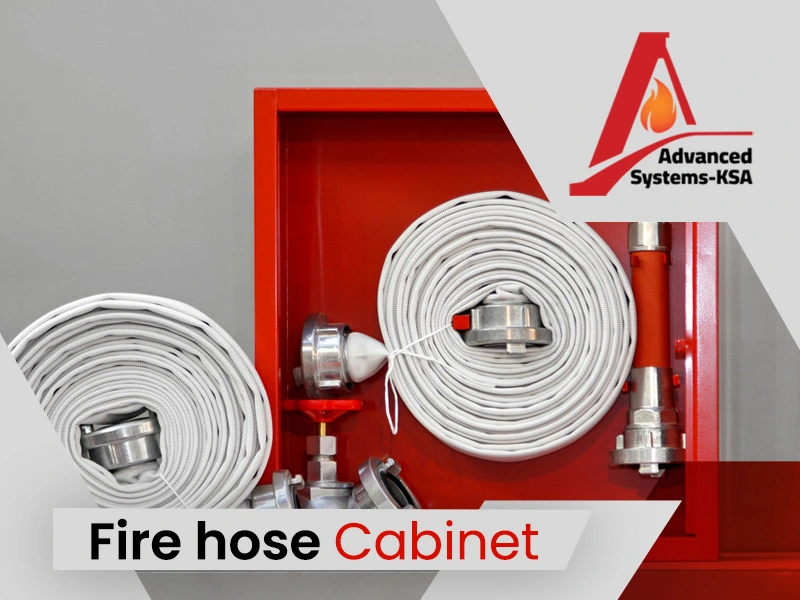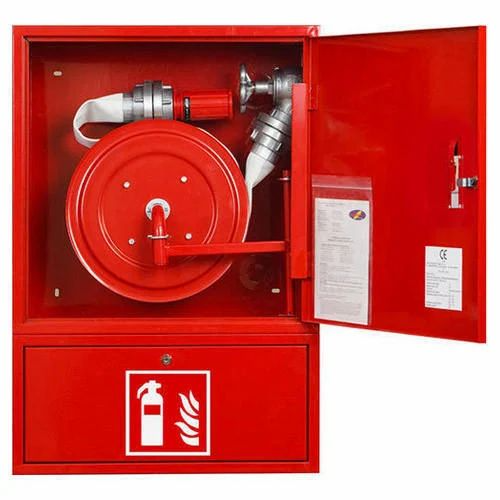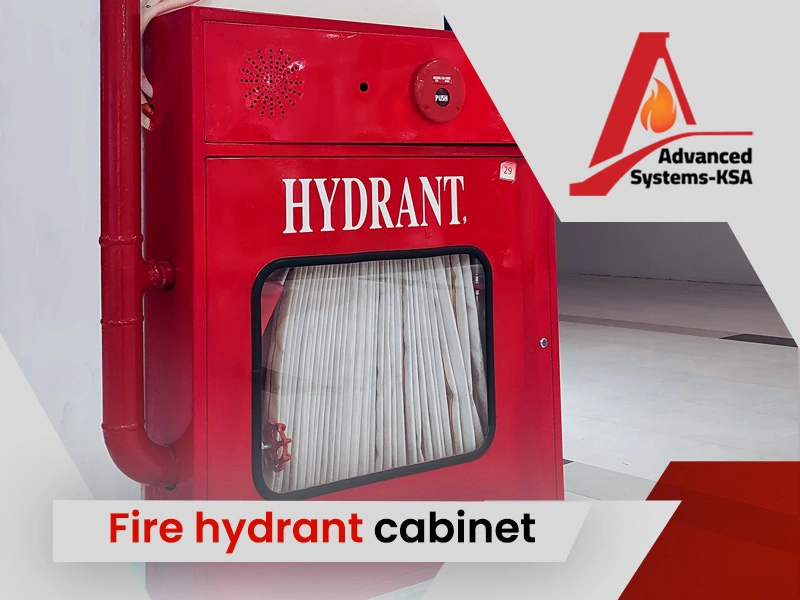Fire hose cabinets are vital for fire safety. They protect and store firefighting equipment.
In Saudi Arabia, these cabinets play a crucial role in safeguarding lives and property. Understanding their components is essential for effective fire management. Saudi Arabia has diverse buildings, from modern skyscrapers to traditional homes. Each requires specific fire safety measures.
Fire hose cabinets are essential in these structures. They house hoses, nozzles, and other firefighting tools. Their design ensures quick access during emergencies. Knowing the components helps in choosing the right cabinet for each location. This knowledge aids in maintenance and compliance with safety standards. As fire safety awareness grows, understanding these components becomes more critical. This blog post will delve into the key elements found in fire hose cabinets across Saudi Arabia.

Credit: adsystems-ksa.com
Introduction To Fire Hose Cabinets
Fire hose cabinets are crucial in ensuring safety during fire emergencies. They house essential firefighting tools. These cabinets are found in buildings across Saudi Arabia. Their design makes them easy to access in case of a fire.
Inside, you will find hoses, nozzles, and other firefighting gear. The cabinet protects these tools from damage. It ensures they are ready for use at any moment. Understanding their components helps in maintaining safety standards.
Purpose And Importance
Fire hose cabinets serve a critical purpose. They provide immediate access to firefighting equipment. Quick response is vital in preventing fire spread. These cabinets help in rapid firefighting action.
They protect hoses and nozzles from wear and tear. This ensures the equipment is always functional. Properly maintained cabinets enhance safety for all building occupants.
Legal Requirements In Saudi Arabia
Saudi Arabia has strict fire safety laws. Fire hose cabinets must meet specific standards. Compliance ensures safety and reduces fire risks.
Regulations require regular inspections of these cabinets. This guarantees that all components are in working order. Non-compliance can lead to penalties or increased risk.
Understanding these requirements is essential for building owners. It ensures both safety and adherence to the law.

Credit: ebdaatrading.com
Types Of Fire Hose Cabinets
Fire hose cabinets in Saudi Arabia often include hoses, nozzles, and valves. These components ensure quick access during emergencies. Cabinets come in various types, such as wall-mounted and recessed.
When you think about fire safety in Saudi Arabia, fire hose cabinets might not be the first thing that comes to mind. However, these cabinets are crucial in ensuring that firefighting equipment is both accessible and protected. Knowing the different types of fire hose cabinets can help you make informed decisions about safety needs for your building or facility. ###Surface-mounted Cabinets
Surface-mounted cabinets are among the most popular choices in Saudi Arabia due to their straightforward installation process. They are affixed directly to the wall, making them ideal for settings where cutting into the wall is not feasible. These cabinets are often seen in older buildings where renovation is restricted, or in areas with high foot traffic where visibility is important. Think of the last time you walked through a busy mall. Did you notice a bright red cabinet on the wall? That’s likely a surface-mounted fire hose cabinet. It’s designed to be easily spotted, ensuring quick access in emergencies. ###Recessed Cabinets
Recessed cabinets offer a sleek, modern look and are built into the wall, making them less obtrusive. They are an excellent choice for new buildings or during major renovations. A recessed cabinet blends seamlessly with its surroundings, which can be aesthetically pleasing while maintaining functionality. Imagine visiting a luxury hotel in Riyadh; the walls appear uninterrupted and elegant. Behind that refined appearance, a recessed fire hose cabinet might be waiting, ready to serve in times of crisis. This type of cabinet is perfect for spaces where design and safety must go hand in hand. ###Semi-recessed Cabinets
Semi-recessed cabinets strike a balance between surface-mounted and recessed options. They extend slightly from the wall, providing a middle ground for those who want a bit of both worlds. They are particularly useful in buildings where wall depth is limited but aesthetics still matter. Picture an office building where the walls are not thick enough for full recessing. A semi-recessed cabinet can be a practical solution. It offers a compromise by providing easy access without sacrificing too much space or visual appeal. Choosing the right type of fire hose cabinet is more than just a technical decision. It involves considering the building’s design, the ease of access in emergencies, and even the impression it leaves on visitors. Which type do you think would best suit your space?Key Components Of Fire Hose Cabinets
When you think about fire safety in Saudi Arabia, fire hose cabinets are crucial. They house essential firefighting equipment that can save lives and property. Knowing the key components of these cabinets can help you understand their importance and ensure they function effectively during emergencies.
Fire Hose Reel
The fire hose reel is a fundamental part of the fire hose cabinet. It’s designed to provide a steady stream of water to combat fires. Typically, these reels hold a long length of hose, wound around a circular drum.
In Saudi Arabia, these reels are often made of robust materials to withstand the harsh climate. They are easy to operate, even for someone without firefighting experience. Simply pull the hose to the desired length and open the valve.
Nozzle Types
The nozzle at the end of the fire hose controls the water flow. There are various types of nozzles, each with unique advantages. Adjustable nozzles allow you to switch between a concentrated stream and a wide spray.
In some situations, a fog nozzle is more effective. It disperses water into tiny droplets, which can absorb heat and reduce smoke. Fixed nozzles, on the other hand, are simpler and more durable, ideal for less experienced users.
Control Valves
Control valves are critical for regulating water pressure and flow. They ensure you have the right amount of water to tackle a fire without causing unnecessary damage. Located near the hose reel, these valves are easy to access and operate.
In Saudi Arabia, control valves are designed to be corrosion-resistant. This is important given the region’s high temperatures and humidity. Regular maintenance of these valves ensures they are always ready for action.
Have you ever wondered if your building’s fire hose cabinet is well-maintained? It’s worth checking. Proper upkeep of these key components can make all the difference in an emergency.
Material And Construction
When you’re considering fire safety equipment, the materials and construction of a fire hose cabinet are crucial aspects you can’t ignore. Whether you’re setting up a new system or upgrading an existing one in Saudi Arabia, understanding what goes into these cabinets can make a significant difference in their performance and longevity. But what makes a fire hose cabinet reliable? Let’s dive into the specifics.
Cabinet Materials
The choice of materials in fire hose cabinets is vital for ensuring they withstand the rigors of emergency situations. You often find cabinets made of steel or aluminum. Steel is renowned for its strength, making it a solid choice for environments where durability is paramount. On the other hand, aluminum offers a lighter alternative, which can be beneficial for ease of installation and handling.
Think about your specific needs. If your cabinet is in a high-traffic area, steel might be your best bet. Yet, if you prioritize ease of access and installation, aluminum could be the material for you. It’s all about balancing strength and practicality.
Durability Standards
Durability is not just about the material; it’s about how these materials are put together. In Saudi Arabia, fire hose cabinets should meet specific standards that guarantee their robustness. Look for cabinets that are compliant with international safety standards. This ensures they have undergone rigorous testing for reliability.
Ask yourself this: would you trust a cabinet that hasn’t been tested for durability? Ensuring your fire hose cabinet meets these standards offers peace of mind, knowing it can withstand the demands of an emergency.
Weather Resistance
The climate in Saudi Arabia can be harsh, with extreme heat and occasional sandstorms. Your fire hose cabinet must be able to handle these conditions without compromising its integrity. Weather-resistant coatings are essential. They protect the cabinet from corrosion and wear, ensuring it remains functional in any weather.
Imagine a cabinet exposed to the elements without protection—it wouldn’t last long. Consider cabinets with powder-coated finishes or specialized treatments to extend their lifespan. Have you thought about how weather affects your fire safety equipment? It’s a crucial consideration that can save you time and money in the long run.
In choosing the right fire hose cabinet, consider these aspects carefully. The materials and construction will affect not only the cabinet’s durability but also your safety. Make informed decisions that suit your environment and needs, and you’ll have a reliable asset in times of emergency.
Installation Guidelines
Proper installation of fire hose cabinets in Saudi Arabia is essential. It ensures safety and functionality during emergencies. Following guidelines can make the process smooth. This section outlines key criteria for installation.
Location Criteria
Fire hose cabinets should be placed in easily accessible areas. Ensure they are not obstructed by furniture or other items. The location must be visible and marked clearly. Install cabinets near exits or main corridors. This allows quick access during emergencies.
Mounting Instructions
Secure the cabinet firmly to the wall. Use appropriate mounting hardware for stability. Choose a height that is easy to reach. Ensure the cabinet does not protrude excessively. This prevents accidents and ensures safe passage.
Accessibility Requirements
Ensure the cabinet is easy to open. Test the door mechanism regularly. Make sure the hose can be pulled out smoothly. Clear the area around the cabinet. This provides ample space for hose operation.
Maintenance And Inspection
Maintenance and inspection of fire hose cabinet components are crucial in Saudi Arabia. Regular checks ensure these safety devices function properly in emergencies. Neglecting maintenance can lead to malfunctions, risking lives and property. Therefore, understanding maintenance and inspection processes is essential. Let’s explore the vital aspects.
Routine Checks
Routine checks are the backbone of fire safety maintenance. Inspect the cabinet for any visible damage. Check for rust, dents, or broken parts. Ensure the hose reel is in good condition. Look for kinks or wear on the hose. Confirm the nozzle operates smoothly. Make sure the cabinet door closes securely.
Repair Protocols
Repairs should be prompt and efficient. Address any damage immediately. Replace damaged hoses or nozzles. Repair or replace faulty cabinet doors. Ensure all parts are functioning correctly. Use approved repair materials and methods. Document all repairs for future reference.
Replacement Procedures
Replacement is necessary when repairs are insufficient. Replace hoses showing significant wear. Change nozzles that do not function properly. Install a new cabinet if the old one is damaged. Ensure all replacements meet safety standards. Keep records of all replacements for accountability.
Safety Standards And Compliance
Safety standards and compliance are crucial in the realm of fire safety. Fire hose cabinets in Saudi Arabia must adhere to strict regulations. These standards ensure the protection of lives and property. Understanding both local and international requirements is essential. It guarantees that these components function optimally in emergencies. Let’s explore the safety standards and compliance aspects.
Saudi Safety Regulations
Saudi Arabia enforces stringent safety rules for fire hose cabinets. The Saudi Building Code (SBC) lays out these requirements. It ensures that fire safety equipment meets specific criteria. The code demands proper installation and maintenance. This safeguards against potential fire hazards. Regular inspections are also required. This ensures that all components are in good working condition.
International Standards
International standards also influence fire safety in Saudi Arabia. The NFPA (National Fire Protection Association) provides guidelines. Their standards help in achieving global safety compliance. ISO (International Organization for Standardization) also plays a role. It offers a framework for quality and safety. Adhering to these standards enhances reliability and efficiency. It ensures that fire hose cabinets perform effectively during fires.

Credit: www.facebook.com
Training And Emergency Preparedness
Training and emergency preparedness are crucial for fire safety. In Saudi Arabia, fire hose cabinet components play a vital role. Ensuring proper training and readiness is essential. It guarantees effective use during emergencies. Regular training sessions and structured plans can save lives.
Fire Safety Training
Fire safety training teaches proper use of fire hose cabinets. It includes practical exercises. Participants learn to handle equipment confidently. Training covers identifying risks and safe evacuation. It emphasizes quick response and efficient teamwork. Professionals conduct these sessions regularly. They ensure every participant understands safety protocols. Consistent training builds confidence in handling emergencies.
Emergency Response Plans
Emergency response plans are vital. They outline actions during a fire. These plans involve organizing resources swiftly. Clear roles and responsibilities are defined. Everyone knows their tasks during crises. Plans are regularly updated to meet safety standards. They include evacuation routes and assembly points. Proper planning reduces panic and confusion. It ensures coordinated efforts during emergencies.
Common Challenges And Solutions
Maintaining fire hose cabinets in Saudi Arabia presents several challenges. These challenges can affect the effectiveness of fire safety systems. Understanding these challenges and their solutions is crucial. Let’s explore the common issues and how to address them.
Environmental Factors
The harsh climate in Saudi Arabia impacts fire hose cabinets. High temperatures can damage hoses and other components. Sandstorms may also cause wear and tear over time. Regular inspections and maintenance help mitigate these effects. Installing cabinets in shaded areas can reduce sun exposure. Using durable materials can withstand harsh conditions better.
Equipment Malfunctions
Equipment malfunctions pose a serious risk. Blocked nozzles and pressure loss are common issues. These problems can delay response times during emergencies. Routine checks ensure all components function properly. Replacing faulty parts promptly prevents malfunctions. Investing in quality equipment reduces the risk of breakdowns.
Human Error
Human error is a significant challenge in fire safety. Improper usage can lead to equipment damage. Lack of training increases the risk of mistakes. Regular training sessions are essential for staff. Clear instructions should be available at all times. Proper signage near cabinets aids in correct usage.
Frequently Asked Questions
What Are The Parts That Make Up A Fire Hose?
A fire hose consists of the hose itself, couplings, a nozzle, and gaskets. The hose transports water. Couplings connect sections. The nozzle controls water flow. Gaskets ensure leak-proof connections. These components work together to deliver water effectively during firefighting operations.
What Should Be In A Fire Hose Cabinet?
A fire hose cabinet should contain a fire hose, nozzle, hose reel, fire extinguisher, and instructions. Ensure all components are in good condition and easily accessible for emergency use. Regularly inspect and maintain the equipment to ensure functionality during a fire emergency.
Proper labeling is essential for quick identification.
What Is The Difference Between Class 3 And Class 2 Fire Hose Cabinets?
Class 3 fire hose cabinets include both a hose and a fire extinguisher. Class 2 cabinets only contain a hose.
What Are The Different Types Of Fire Hose Cabinets?
There are three main types of fire hose cabinets: recessed, surface-mounted, and semi-recessed. Each type suits different installation needs and locations.
Conclusion
Fire hose cabinets are essential for safety in Saudi Arabia. Each component plays a crucial role in fire protection. Understanding these parts helps ensure readiness during emergencies. Regular checks and maintenance keep the equipment effective. Choose quality materials to withstand Saudi Arabia’s climate.
Proper installation guarantees quick access when needed most. Educate your team about using the equipment efficiently. This knowledge can save lives and property. Make safety a priority by investing in reliable fire hose cabinets. Stay prepared and protect your community from fire risks.

